A Novel Technical Framework for Colombia’s Distribution System Operator with Distributed Energy Resources Integration
Abstract
1. Introduction
- A comprehensive analysis of the new DSO is proposed to provide the basis for an existing operator to adapt this new operating scheme.
- New technical requirements are proposed to conceive a new DSO in Colombia, classifying them into hardware, software, and communication protocols.
- Redefinition of Smart Grid standards and models to enable the integration of new technologies (AMI, BES, ADA, and DER) and functions (DER management, real-time data readings, accurate fault location, and automatic service restoration, among others) into the grid is discussed.
2. Towards a New Distribution System Operator
2.1. New Distribution System Operator (DSO)
2.2. Distributed Energy Resources (DER)
3. Intelligent Grid Standards and Models
3.1. IEEE 2030 Guide for Smart Grid [11]
3.2. NIST Framework Release 4.0 [12]
3.3. SGAM (Smart Grid Architecture Model) [13]
3.4. IEC 62357-1:2016 Reference Architecture [14]
3.5. Colombia Inteligente Initiative Architecture [15]
4. Technical Requirements for the New DSO Role
4.1. Physical Components
- Smart meter;
- Data concentrator unit (DCU);
- Electric vehicle supply equipment (EVSE);
- DER controller;
- Power electronic converter;
- Phasor measurement unit (PMU);
- Intelligent electronic device (IED);
- Merging unit (MU);
- GPS clock;
- Recloser;
- On-load tap changer (OLTC);
- Energy storage devices;
- Information communication technology (ICT) infrastructures.
4.2. Logic Components
4.2.1. Head End System (HES)
4.2.2. Meter Data Management System (MDMS)
4.2.3. Customer Information System (CIS)
4.2.4. Distributed Energy Resources Management System (DERMS)
4.2.5. Supervisory Control and Data Acquisition (SCADA)
- Ensure uninterrupted power supply in a safe environment;
- Provide real-time status of the electrical system;
- Monitor and control systems located in remote areas.
4.2.6. Advanced Distribution Management Systems (ADMS)
- Power distribution system monitoring.
- Decision-making and support tools.
- Power distribution system control.
- Power distribution system operational planning.
- Power distribution system engineering studies.
- Retail power market.
- Training simulator system.
- Quality control (development) system.
4.2.7. Geographic Information System (GIS)
4.2.8. Energy Management System (EMS)
4.3. Communication Protocols
4.3.1. IEC 61850: Communication Networks and Systems for Power Utility Automation
4.3.2. IEC 62056: Electricity Metering Data Exchange (DLMS/COSEM)
4.3.3. IEC 61400-25-2: Communications for Monitoring and Control of Wind Power Plants
4.3.4. IEC 60870-6: Telecontrol in Electrical Engineering and Power System Automation Applications
4.3.5. IEEE 1588: Precision Time Protocol (PTP)
4.3.6. IEEE 1815: Standard for Electric Power Systems Communications-Distributed Network Protocol (DNP3)
4.3.7. IEC 61968: Application Integration at Electric Utilities System Interfaces for Distribution Management
4.3.8. IEC 62746: Systems Interface Between Customer Energy Management System and the Power Management System
4.3.9. IEC 62325: Common Information Model (CIM) for Energy Market Communication
4.3.10. IEEE 1547-2018: Common Information Model (CIM) for Energy Market Communication
5. Energy System Context and Definition of the Technical Requirements for the Design of a New DSO in Colombia
5.1. The Context of the Colombian Energy System
5.1.1. Policy and Regulatory Context
5.1.2. Technological Context
5.1.3. Current System Status and Distribution Operation
5.2. Definition of Technical Requirements for the New DSO in Colombia
6. Conclusions
Author Contributions
Funding
Data Availability Statement
Acknowledgments
Conflicts of Interest
Nomenclature
| ADA | Advanced Distribution Automation |
| ADMS | Advanced Distribution Management System |
| AMI | Advanced Metering Infrastructure |
| BES | Battery Energy Storage |
| CIM | Common Information Model |
| CIS | Customer Information System |
| COSEM | Companion Specification for Energy Metering |
| DCU | Data Concentrator Unit |
| DER | Distributed Energy Resources |
| DMLS | Device Language Message Specification |
| DMS | Distribution Management System |
| DNO | Distribution Network Operator |
| DOE | U.S. Department of Energy |
| DRMS | Demand Response Management Systems |
| DSO | Distribution System Operator |
| EMS | Energy Management System |
| EVSE | Electric Vehicle Supply Equipment |
| GIS | Geographic Information System |
| GPS | Global Positioning System |
| IED | Intelligent Electronic Device |
| MDMS | Meter Data Management System |
| MU | Merging Unit |
| OLTC | On-Load Tap Changer |
| OMS | Outage Management System |
| PMU | Phasor Measurement Unit |
| PTP | Precision Time Protocol |
| SCADA | Supervisory Control and Data Acquisition |
| SGAM | Smart Grid Architecture Model |
| SGIRM | Smart Grid Interoperability Reference Model |
References
- MIT Energy Initiative. Utility of the Future; Massachusetts Institute of Technology: Cambridge, MA, USA, 2016. [Google Scholar]
- International Renewable Energy Agency (IRENA). World Energy Transitions Outlook 2022; International Renewable Energy Agency: Abu Dhabi, United Arab Emirates, 2022. [Google Scholar]
- Cerón, J.A.; Gómez-Luna, E.; Vasquez, J.C. Driving the Energy Transition in Colombia for Off-Grid Regions: Microgrids and Non-Conventional Renewable Energy Sources. Energies 2025, 18, 1010. [Google Scholar] [CrossRef]
- Lopez Alzate, Y.; Gómez-Luna, E.; Vasquez, J.C. Innovative Microgrid Services and Applications in Electric Grids: Enhancing Energy Management and Grid Integration. Energies 2024, 17, 5567. [Google Scholar] [CrossRef]
- Escobar-Orozco, L.F.; Gómez-Luna, E.; Marlés-Sáenz, E. Identification and Analysis of Technical Impacts in the Electric Power System Due to the Integration of Microgrids. Energies 2023, 16, 6412. [Google Scholar] [CrossRef]
- International Renewable Energy Agency. Innovation Landscape Brief: Future Role of Distribution System Operators; International Renewable Energy Agency: Abu Dhabi, United Arab Emirates, 2019. [Google Scholar]
- Vlerick Energy Centre. Outlook on the European DSO Landscape 2020; Vlerick Energy Centre: Brussels, Belgium, 2020. [Google Scholar]
- Specht, M.; Rohjans, S.; Trefke, J.; Uslar, M.; Gonzalez Vazquez, J.M. International Smart Grid Roadmaps and Their Assessment. EAI Endorsed Trans. Energy Web 2013, 1, e2. Available online: https://eudl.eu/doi/10.4108/trans.ew.2013.01-06.e2 (accessed on 22 April 2025).
- Nyangon, J. Distributed Energy Generation Systems Based on Renewable Energy and Natural Gas Blending: New Business Models for Economic Incentives, Electricity Market Design and Regulatory Innovation. Ph.D. Thesis, University of Delaware, Newark, DE, USA, 2017. [Google Scholar] [CrossRef]
- Apostolopoulou, D.; Bahramirad, S.; Khodaei, A. The Interface of Power: Moving Toward Distribution System Operators. IEEE Power Energy Mag. 2016, 14, 46–51. [Google Scholar] [CrossRef]
- IEEE Std 2030-2011; IEEE Guide for Smart Grid Interoperability of Energy Technology and Information Technology Operation with the Electric Power System (EPS), End-Use Applications, and Loads. IEEE: Piscataway, NJ, USA, 2011.
- Gopstein, A.; Nguyen, C.; O’Fallon, C.; Hastings, N.; Wollman, D. NIST Framework and Roadmap for Smart Grid Interoperability Standards, Release 4.0; NIST: Gaithersburg, MD, USA, 2021. [Google Scholar] [CrossRef]
- Smart Grid Coordination Group. Smart Grid Reference Architecture, CEN-CENELEC-ETSI. 2012. Available online: https://www.cencenelec.eu/media/CEN-CENELEC/AreasOfWork/CEN-CENELEC_Topics/Smart%20Grids%20and%20Meters/Smart%20Grids/reference_architecture_smartgrids.pdf (accessed on 24 February 2024).
- IEC TR 62357-1; Power Systems Management and Associated Information Exchange—Part 1: Reference Architecture. The International Electrotechnical Commission (IEC): Geneva, Switzerland, 2016.
- Colombia Inteligente. Recursos Energéticos Distribuidos. In Acciones Para Su Integración; Colombia Inteligente: Medellín, Colombia, 2020. [Google Scholar]
- Rahimi, F.; Mokhtari, S. A New Distribution System Operator Construct; Open Access Technology International, Inc.: Bloomington, MN, USA, 2014; pp. 1–20. [Google Scholar]
- Scottish & Soutern Electricity Networks. NINES. Available online: https://ssen-innovation.co.uk/nines/ (accessed on 24 February 2024).
- OFGEM. Network Price Controls 2021-2028 (RIIO-2). Available online: https://www.ofgem.gov.uk/energy-policy-and-regulation/policy-and-regulatory-programmes/network-price-controls-2021-2028-riio-2 (accessed on 29 February 2024).
- NYISO. Reforming the Energy Vision (REV)-DSIP/DSP. Available online: https://www.nyiso.com/documents (accessed on 24 February 2024).
- The Federal Energy Regulatory Commission (FERC). FERC Order No. 2222 Explainer: Facilitating Participation in Electricity Markets by Distributed Energy Resources. Available online: https://www.ferc.gov/ferc-order-no-2222-explainer-facilitating-participation-electricity-markets-distributed-energy (accessed on 28 February 2024).
- European Distribution System Operators (E.DSO). CoordiNet. Available online: https://www.edsoforsmartgrids.eu/eu-projects/coordinet/ (accessed on 22 April 2025).
- OneNet. OneNet-Demos. Available online: https://www.onenet-project.eu/demos/ (accessed on 28 February 2024).
- Palensky, P.; Dietrich, D. Demand Side Management: Demand Response, Intelligent Energy Systems, and Smart Loads. IEEE Trans. Ind. Inform. 2011, 7, 381–388. [Google Scholar] [CrossRef]
- Shen, J.; Jiang, C.; Li, B. Controllable Load Management Approaches in Smart Grids. Energies 2015, 8, 11187–11202. [Google Scholar] [CrossRef]
- Stefano de Souza Pelegrino, L.; Heldwein, M.L.; Waltrich, G. Integrated System for Power Flow Control between Electric Vehicle, Utility Grid and Residence. IET Power Electron. 2020, 13, 953–960. [Google Scholar] [CrossRef]
- Xia, W.; Hou, E.; Mao, X.; Wang, L. Hyperscale AMI System Design and Construction Practice. In Proceedings of the 11th IET International Conference on Advances in Power System Control, Operation and Management (APSCOM 2018), Hong Kong, China, 11–15 November 2018; pp. 1–5. [Google Scholar] [CrossRef]
- IEC TR 62357-2:2019; Power Systems Management and Associated Information Exchange—Part 2: Use Cases and Role Model. The International Electrotechnical Commission (IEC): Geneva, Switzerland, 2019.
- Norfazlina, G.; Akma, A.S.S.; Adrina, S.N.; Noorizan, M.M. Customer Information System Satisfaction and Task Productivity: The Moderating Effect of Training. Procedia Econ. Financ. 2016, 37, 7–12. [Google Scholar] [CrossRef]
- Strezoski, L.; Padullaparti, H.; Ding, F.; Baggu, M. Integration of Utility Distributed Energy Resource Management System and Aggregators for Evolving Distribution System Operators. J. Mod. Power Syst. Clean Energy 2022, 10, 277–285. [Google Scholar] [CrossRef]
- Ordean, M.; Chiorean, D.; Rogoz, I.; Lehene, C.; Stoian, I.; Stancel, E. SCADA Systems—Support for the Maintenance Management of Hydro Power Plants. In Proceedings of the 2006 IEEE International Conference on Automation, Quality and Testing, Robotics, Cluj-Napoca, Romania, 25–28 May 2006; Volume 1, pp. 238–242. [Google Scholar] [CrossRef]
- Amiri, S.S.; Rahmani, M.; McDonald, J.D. An Updated Review on Distribution Management Systems within a Smart Grid Structure. In Proceedings of the 2021 11th Smart Grid Conference (SGC), Tabriz, Iran, 7–9 December 2021; pp. 1–5. [Google Scholar] [CrossRef]
- Abdulrahman, I.; Radman, G. Power System Spatial Analysis and Visualization Using Geographic Information System (GIS). Spat. Inf. Res. 2020, 28, 101–112. [Google Scholar] [CrossRef]
- Ahmad, S.; Shafiullah, M.; Ahmed, C.B.; Alowaifeer, M. A Review of Microgrid Energy Management and Control Strategies. IEEE Access 2023, 11, 21729–21757. [Google Scholar] [CrossRef]
- Otani, T. A Primary Evaluation for Applicability of IEC 62056 to a Next-Generation Power Grid. In Proceedings of the 2010 First IEEE International Conference on Smart Grid Communications, Gaithersburg, MD, USA, 4–6 October 2010; pp. 67–72. [Google Scholar] [CrossRef]
- Lee, J.-H.; Seo, M.-J.; Kim, G.-S.; Lee, H.-H. IEC 61400-25 Interface Using MMS and Web Service for Remote Supervisory Control at Wind Power Plants. In Proceedings of the 2008 International Conference on Control, Automation and Systems, Seoul, Republic of Korea, 14–17 October 2008; pp. 2719–2723. [Google Scholar] [CrossRef]
- IEEE Std 1588-2019 (Revision ofIEEE Std 1588-2008); IEEE Standard for a Precision Clock Synchronization Protocol for Networked Measurement and Control Systems. IEEE: Piscataway, NJ, USA, 2020; pp. 1–499. [CrossRef]
- IEEE Std 1815-2012 (Revision of IEEE Std 1815-2010); IEEE Standard for Electric Power Systems Communications-Distributed Network Protocol (DNP3). IEEE: Piscataway, NJ, USA, 2012; pp. 1–821. [CrossRef]
- Lv, G.; Zhao, J.; Su, J.; Zhang, D. Research on IEC 61968 Standard Oriented Function Framework of Adapter in Smart Distribution Grid. In Proceedings of the 2013 Fourth International Conference on Digital Manufacturing & Automation, Shinan, China, 29–30 June 2013; pp. 1061–1065. [Google Scholar] [CrossRef]
- Keko, H.; Keserica, H.; Sučić, S.; Miranda, V. Technical Backbone for the Democratization of Flexibility: Standards-Based Demand Response Infrastructure. In Proceedings of the 2019 16th International Conference on the European Energy Market (EEM), Ljubljana, Slovenia, 18–20 September 2019; pp. 1–5. [Google Scholar] [CrossRef]
- Shao, P.; Ye, F.; Guo, Y.; Liu, Y.; Zhang, J.; Wang, G. Power Market Unified Model Technology Architecture Based on IEC 62325. In Proceedings of the 2019 IEEE 3rd Information Technology, Networking, Electronic and Automation Control Conference (ITNEC), Chengdu, China, 15–17 March 2019; pp. 1474–1477. [Google Scholar] [CrossRef]
- IEEE Std 1547-2018 (Revision of IEEE Std 1547-2003); IEEE Standard for Interconnection and Interoperability of Distributed Energy Resources with Associated Electric Power Systems Interfaces. IEEE: Piscataway, NJ, USA, 2018; pp. 1–138. [CrossRef]
- UPME. Plan Energético Nacional Colombia: Ideario Energético 2050; Unidad Planeación Min. Energética, Repub: Colomb, Sri Lanka, 2015; Volume 184. [Google Scholar]
- La Unidad de Planeación Minero Energética—UPME. Smart Grids Colombia Visión 2030—Parte I; UPME: Bogotá, Colombia, 2016. [Google Scholar]
- Gómez, J.R. Smart Grids Colombia, Visión 2030 Hoja de Ruta. In Proceedings of the XIII ASOCODIS Jornada de Distribución de Energía Eléctrica, Bogotá, Colombia. 2016. Available online: https://www.asocodis.org.co/docs/XIII-Jornada/Sesion%20II/BID_SmartGrid_Colombia_2016.pdf (accessed on 22 April 2025).
- Resolución CREG 038 de 2014; Modificación Código de Medida Contenido en el Anexo General del Código de Redes; Comisión de Regulación de Energía y Gas: Bogotá, Colombia, 2014. Available online: https://gestornormativo.creg.gov.co/gestor/entorno/docs/resolucion_creg_0038_2014.htm (accessed on 22 April 2025).
- Resolución CREG 015 de 2018; Metodología para la Remuneración de la Actividad de Distribución de Energía Eléctrica en el Sistema Interconectado Nacional; Comisión de Regulación de Energía y Gas: Bogotá, Colombia, 2018. Available online: https://gestornormativo.creg.gov.co/gestor/entorno/docs/resolucion_creg_0015_2018.htm (accessed on 22 April 2025).
- NTC 6079 de 2021; Requisitos para Sistemas de Infraestructura de Medición Avanzada (AMI) en Redes de Distribución de Energía Eléctrica. Instituto Colombiano de Normas Técnicas y Certificación: Bogotá, Colombia, 2021.
- Law 1715 de 2014; Regulación para la Integración de las Energías Renovables No Convencionales al SISTEMA Energético Nacional; Congreso de Colombia: Bogotá, Colombia, 2014. Available online: https://www.funcionpublica.gov.co/eva/gestornormativo/norma.php?i=57353 (accessed on 22 April 2025).
- Decreto 2492 de 2014; Adopción de Disposiciones en Materia de Implementación de Mecanismos de Respuesta de la Demanda; Presidencia de la República de Colombia: Bogotá, Colombia, 2014. Available online: https://www.funcionpublica.gov.co/eva/gestornormativo/norma.php?i=60174 (accessed on 22 April 2025).
- Resolución CREG 101 019 de 2022; Regulación del Anillo de Seguridad del Cargo por Confiabilidad Denominado Demanda Desconectable Voluntaria; Comisión de Regulación de Energía y Gas: Bogotá, Colombia, 2022. Available online: https://gestornormativo.creg.gov.co/gestor/entorno/docs/resolucion_creg_101-19_2022.htm (accessed on 22 April 2025).
- Resolución CREG 11 de 2015; Regulación Programa de Respuesta de la Demanda para el Mercado Diario en Condición Crítica; Comisión de Regulación de Energía y Gas: Bogotá, Colombia, 2015. Available online: https://gestornormativo.creg.gov.co/gestor/entorno/docs/resolucion_creg_0011_2015.htm (accessed on 22 April 2025).
- Resolución CREG 174 de 2021; Regulación Actividades de Autogeneración a Pequeña Escala y de Generación Distribuida en el Sistema Interconectado Nacional; Comisión de Regulación de Energía y Gas: Bogotá, Colombia, 2021. Available online: https://gestornormativo.creg.gov.co/gestor/entorno/docs/resolucion_creg_0174_2021.htm (accessed on 22 April 2025).
- Resolución CREG 148 de 2021; Regulación para Permitir Conexión y Operación de Plantas Solares Fotovoltaicas y Eólicas en el SDL Con Capacidad Efectiva Neta o Potencia Máxima Declarada Igual o Mayor a 5 MW y se Dictan Otras Disposiciones; Comisión de Regulación de Energía y Gas: Bogotá, Colombia, 2021. Available online: https://gestornormativo.creg.gov.co/gestor/entorno/docs/resolucion_creg_0148_2021.htm (accessed on 22 April 2025).
- Resolución CREG 101 072 de 2025; Regulación para la Integración de las Comunidades Energéticas al Sistema Energético Nacional y se Dictan otras Disposiciones; Comisión de Regulación de Energía y Gas: Bogotá, Colombia, 2025. Available online: https://gestornormativo.creg.gov.co/gestor/entorno/docs/originales/Resoluci%C3%B3n_CREG_101_072_2025/Resoluci%C3%B3n_CREG_101_072_2025.pdf (accessed on 22 April 2025).
- Carbon Trust. Reporte Final del Proyecto: Apoyo al Despliegue de Tecnologías de Redes Inteligentes en Colombia; Carbon Trust: London, UK, 2020. Available online: https://www1.upme.gov.co/DemandayEficiencia/Documents/Reporte_Final_Despliegue_Redes_Inteligentes.pdf (accessed on 22 April 2025).
- La Unidad de Planeación Minero Energética—UPME. Smart Grids Colombia Visión 2030—Parte II; UPME: Bogotá, Colombia, 2016. [Google Scholar]
- Quiroga Rubio, L. Con un Riesgo de Racionamiento de Energía Latente, Gobierno Estudia Medidas Adicionales. El País. 16 March 2016. Available online: https://www.eltiempo.com/economia/sectores/con-un-riesgo-de-racionamiento-de-energia-sobre-la-mesa-gobierno-estudia-nuevas-medidas-3334105 (accessed on 26 February 2024).
- Reynoso, L. Colombia Se Enfrenta Al Riesgo de Quedarse a Oscuras Ante La Falta de Energía. El País, 17 April 2024. [Google Scholar]
- Colombia Inteligente. Guía Arquitectura Tecnológica Sistema Interconectado Nacional; Colombia Inteligente: Medellín, Colombia, 2020. [Google Scholar]
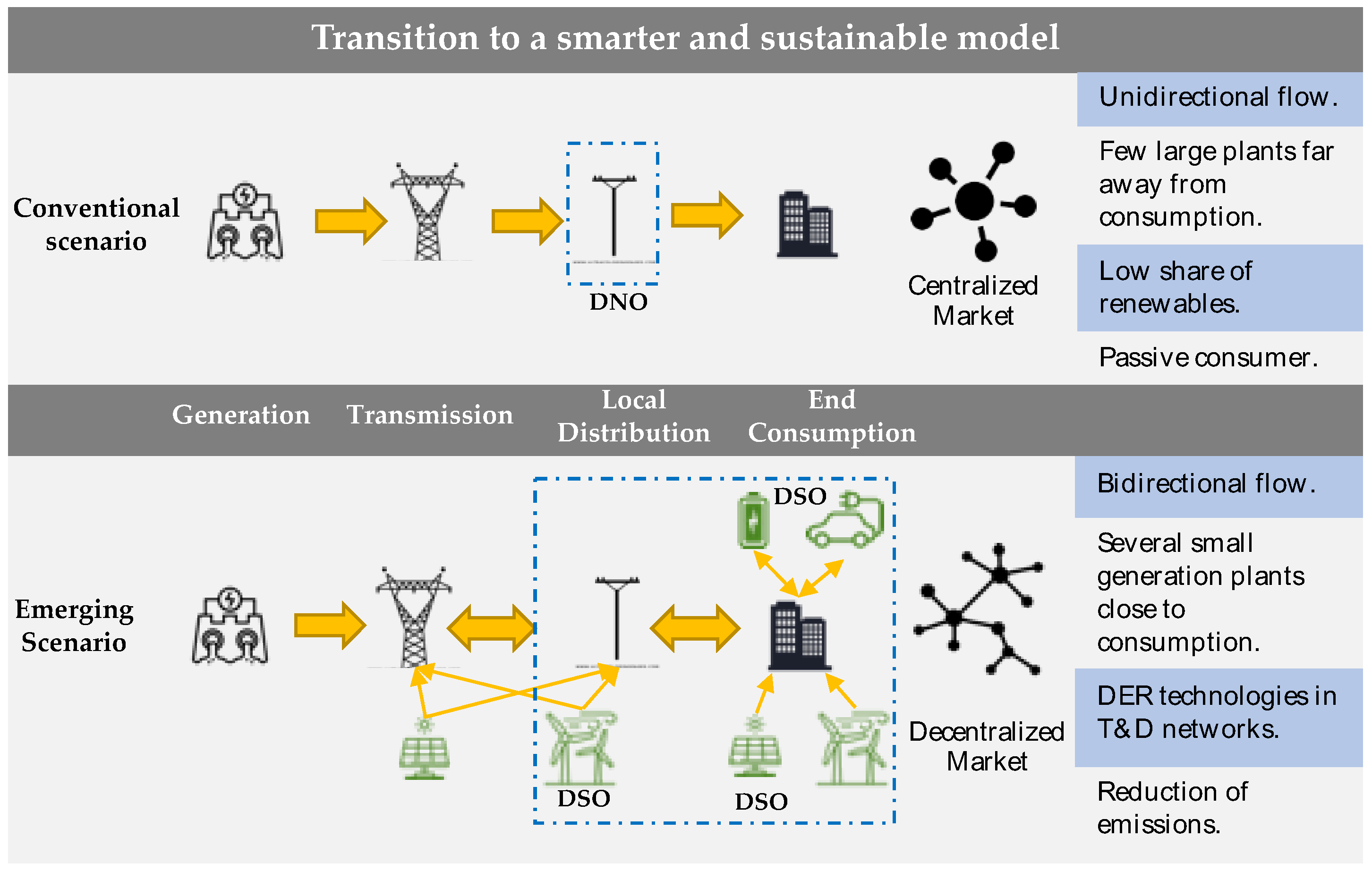
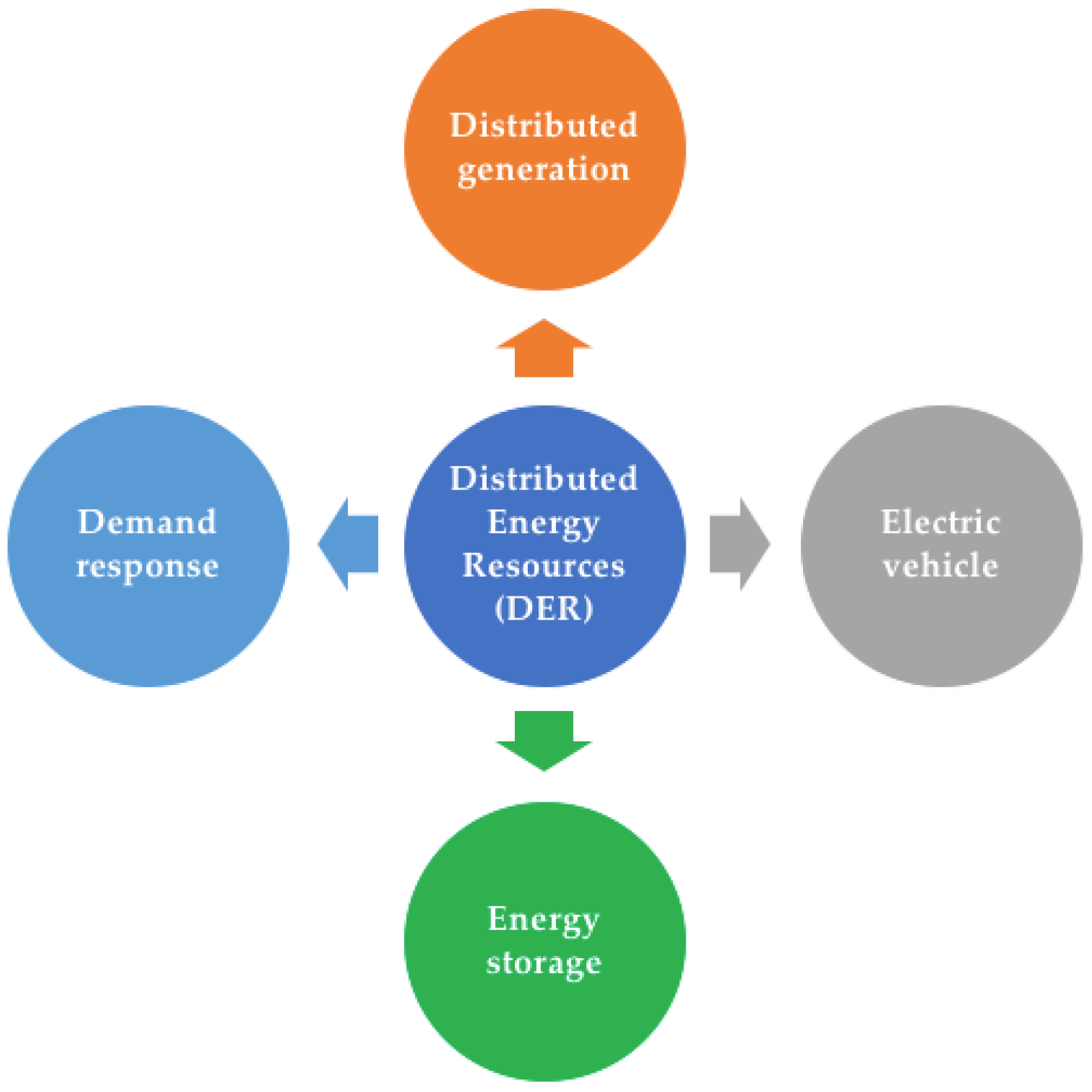
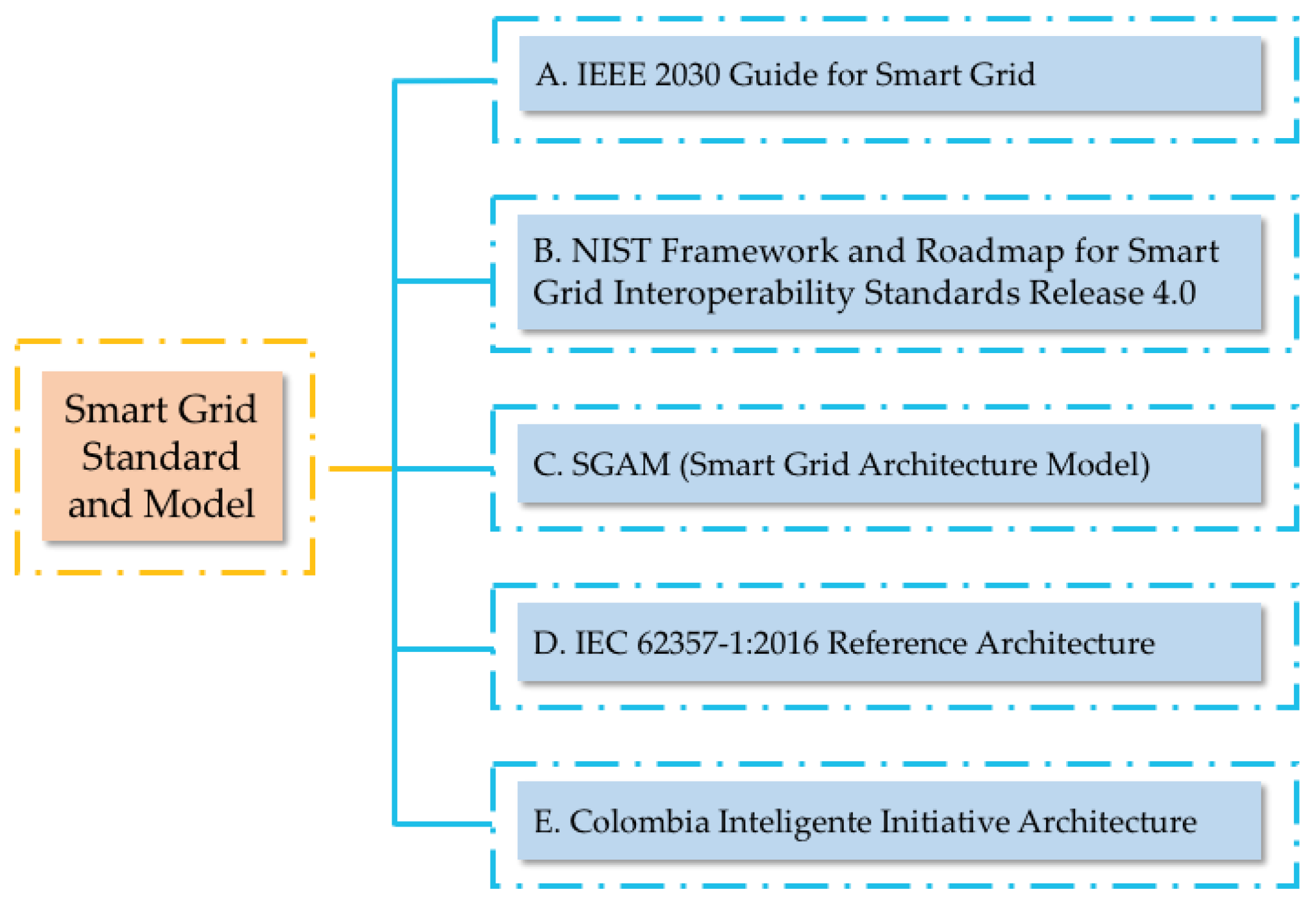
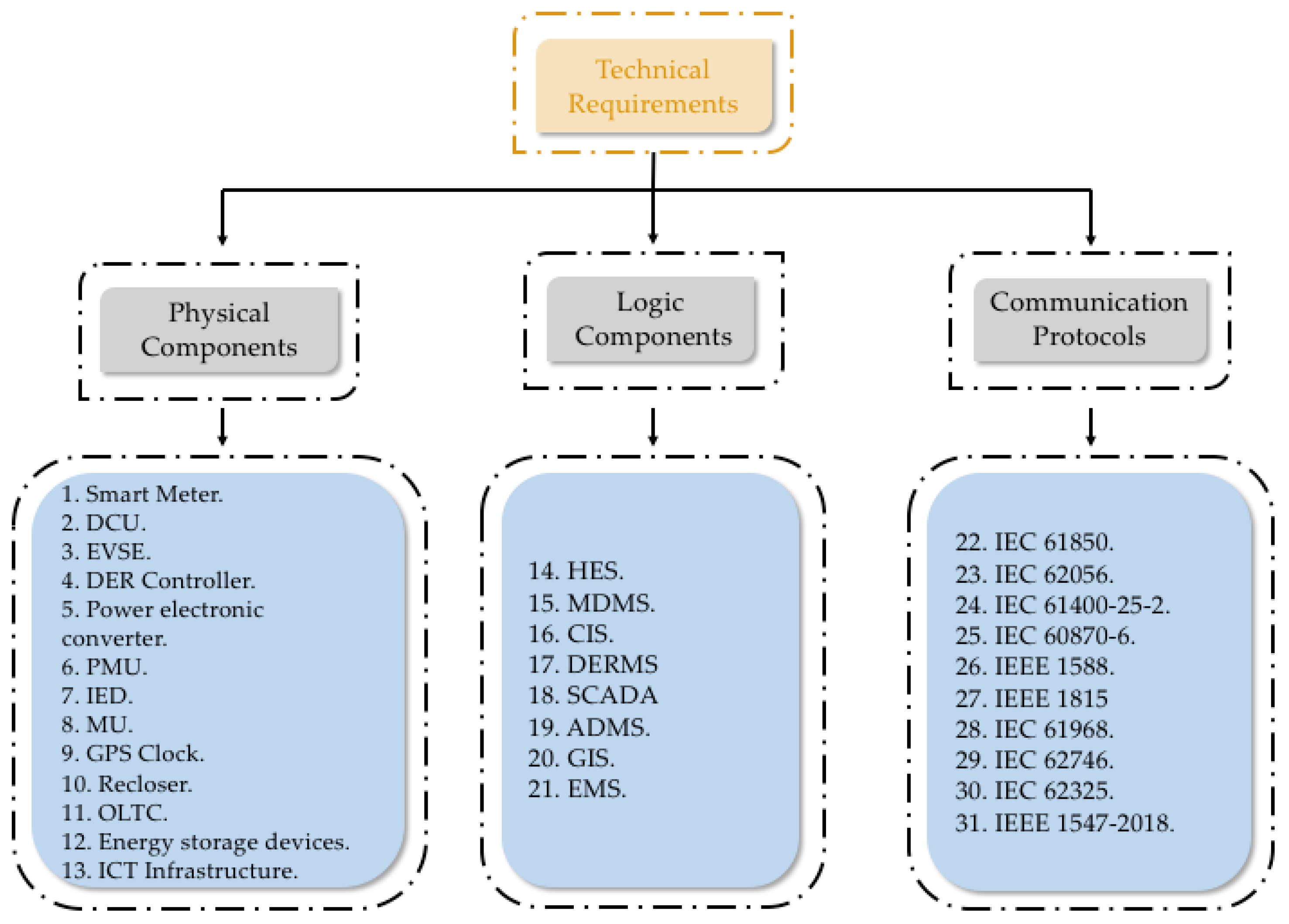
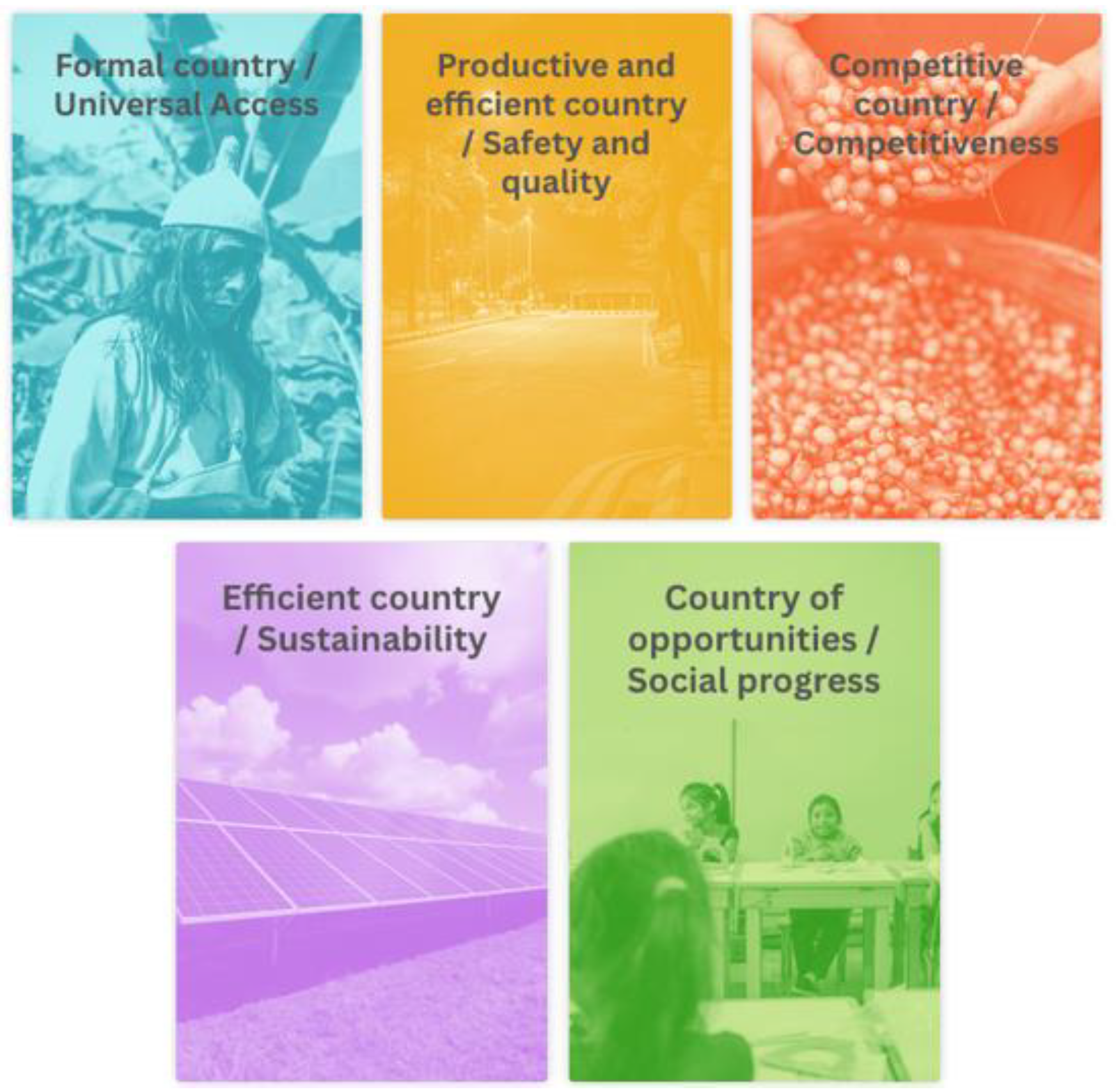
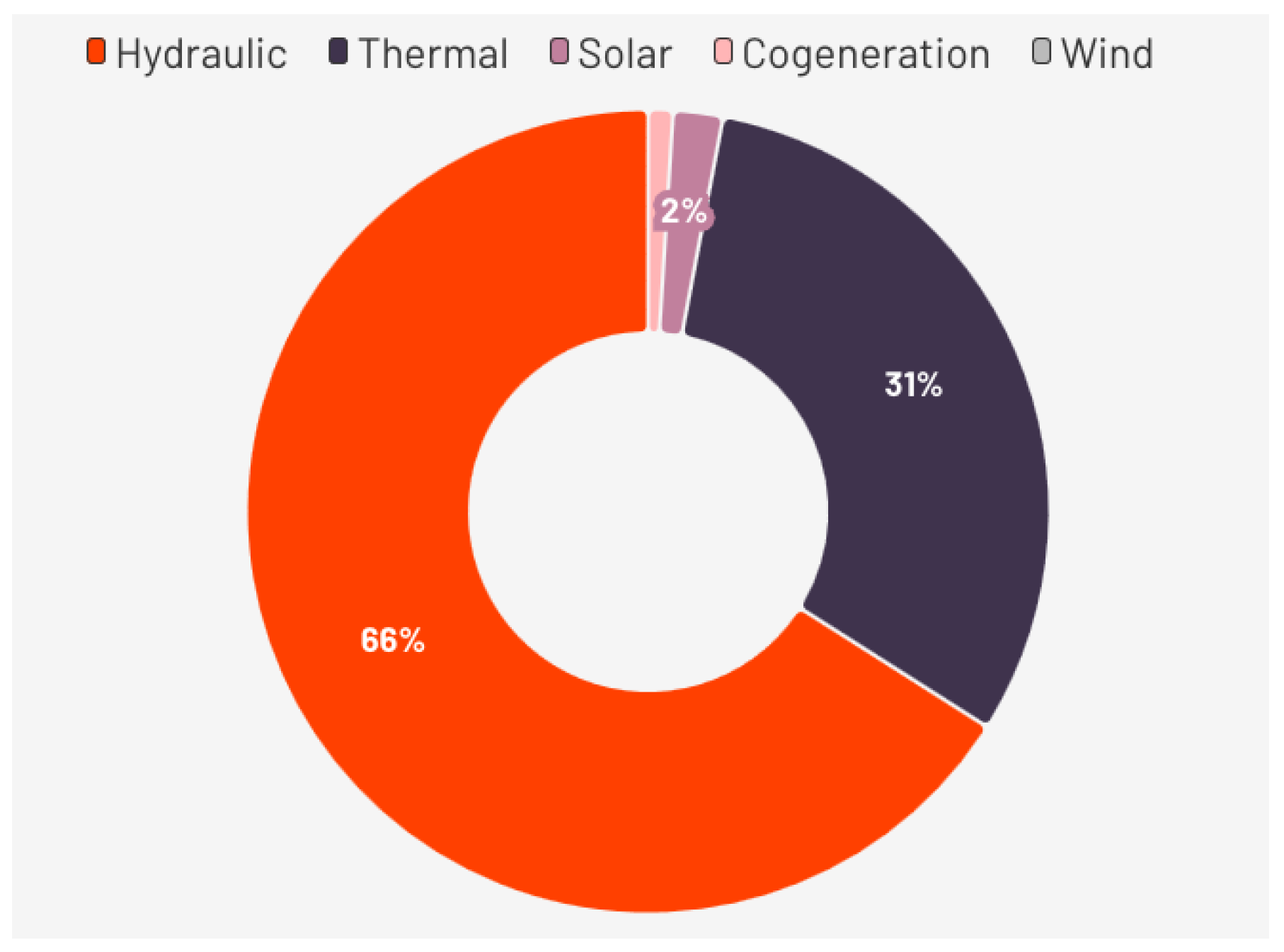
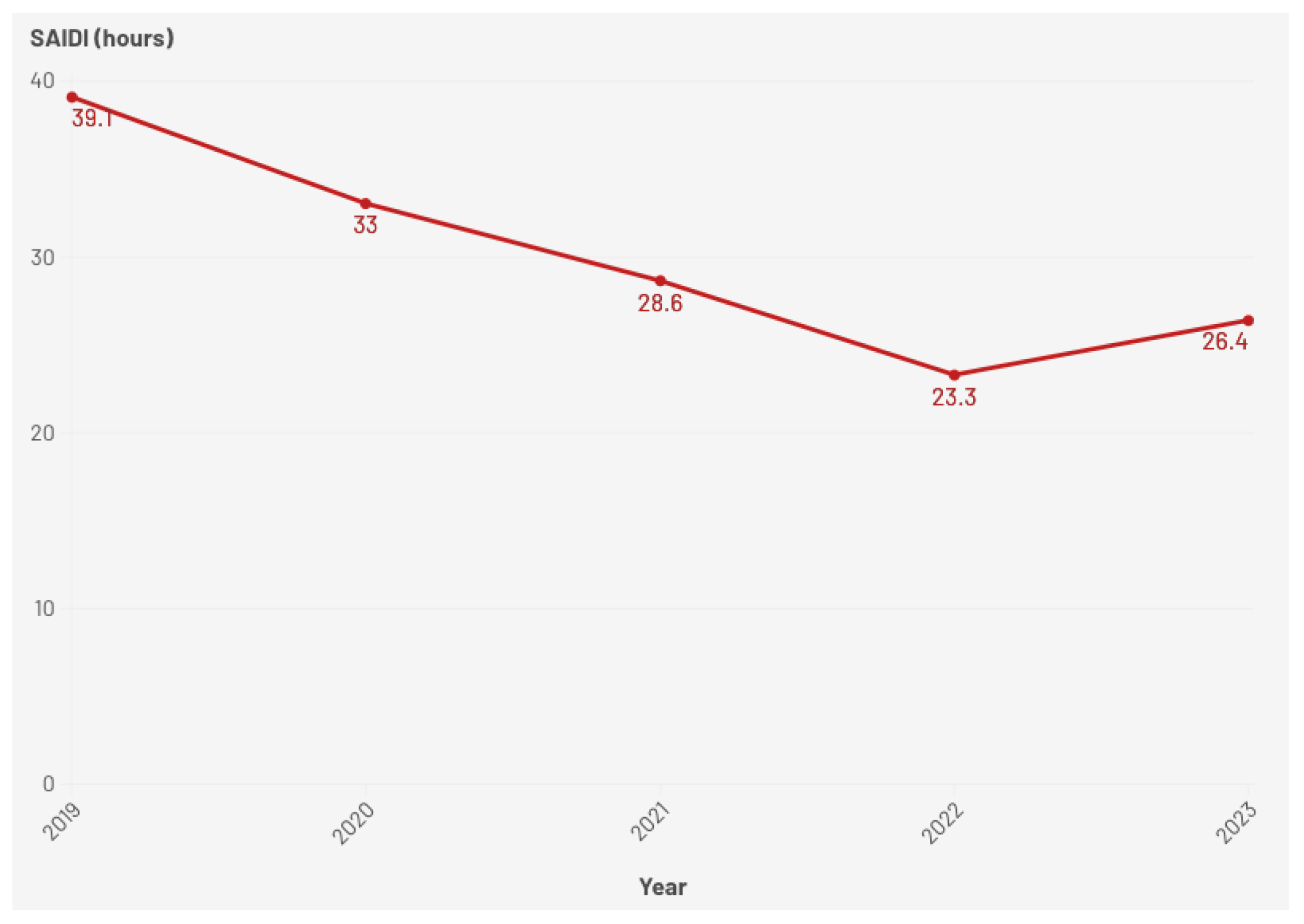
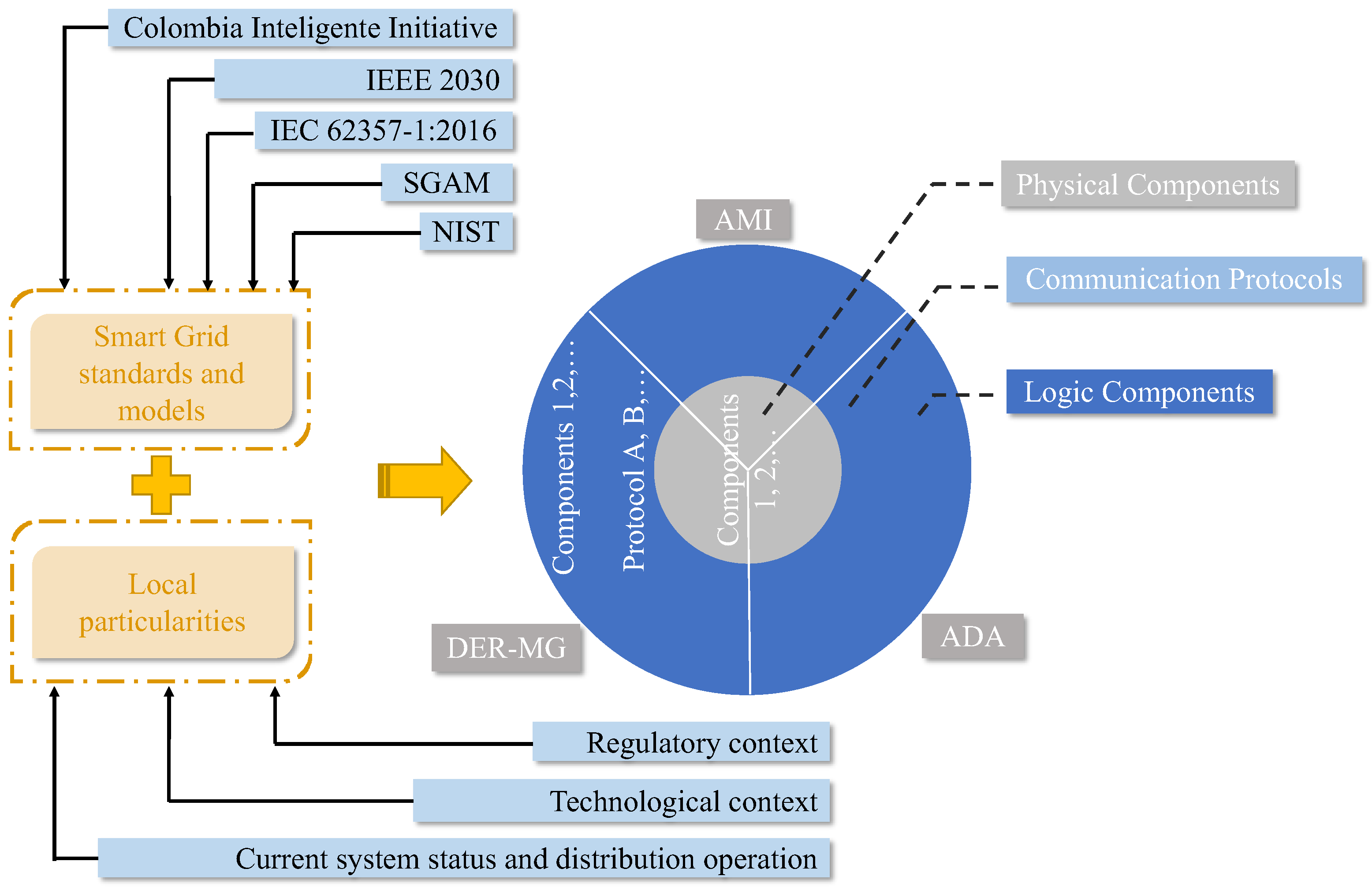
| Location | Country/State | Initiative | Remarks |
|---|---|---|---|
| United Kingdom | Scotland | NINES [17] | Provide an affordable and reliable energy system that takes advantage of renewable sources. Implement the necessary infrastructure for active demand management, generation, and storage. |
| Great Britain | RIIO [18] | Regulatory framework that implements price controls on tariffs while incentivizing operators to innovate. | |
| United States | New York | REV Program [19] | Adoption of DER through incentives, development of renewable sources, and microgrids. Enabling a neutral market between suppliers and consumers. |
| FERC 2222 [20] | Regulation focused on enabling DERs to participate in wholesale electricity markets, thereby accelerating the energy transition. | ||
| European Union | Spain | CoordiNet [21] | Increase the efficiency and quantity of renewable energy by developing new platforms that enable interaction between different actors in the system. |
| OneNet [22] | Create a replicable and scalable architecture that enables integrity in the operation of the European electricity system with a fully decentralized market. | ||
| Sweden | CoordiNet [21] | Provide a market platform and flexible tools for DSOs to manage demand while avoiding grid infrastructure upgrades. Enable increased wind energy production through a P2P digital marketplace. | |
| Greece | CoordiNet [21] | Development of a local market and implementation of innovative coordination schemes that allow consumers and small actors to access the flexibility market and facilitate their active role in the management and operation of the system. |
| Technology | Policy/Regulation | Opportunities | Barriers |
|---|---|---|---|
| AMI | CREG 038-2014 [45] | Free agreement between the parties to define the ownership of the measurement system. | Stakeholders do not consider the positive externalities of smart metering deployment; instead, they focus on how and by whom the implementation costs will be recognized. |
| CREG 015-2018 [46] | Methodology for the calculation of hourly charges that discriminates between different periods according to the system load level. | This feature is only available to users with smart meters. | |
| NTC 6079-2021 [47] | Colombian technical standard that establishes minimum requirements for the management and operation of AMI systems. | No barriers were identified in relation to the technology studied. | |
| Sectoral policy ICT | Protection of the privacy of information of constitutional origin. Consumption data are collected and processed with the owner’s authorization. Implementation of information security systems by the independent system operator (ISO). National policy on cybersecurity since 2011. | A Colombian Electricity Sector Computer Security Incident Response Team (CSIRT) has not been set up. | |
| ADA | Ley 1715-2014 [48] | Promotes the implementation of non-conventional renewable energy sources, rational use of SIN energy, and DR projects. | No barriers were identified in relation to the technology studied. |
| Executive Order 2492/2014 [49] | Design of mechanisms to encourage the efficient use of infrastructure and reduce service provision costs. | No barriers were identified in relation to the technology studied. | |
| CREG 015-2018 [46] | It encourages infrastructure modernization through incentives and compensation schemes that improve service quality. | Some features are only available to users with smart meters. | |
| CREG 101 019-2022 [50] | Voluntary disconnectable demand scheme as a safety ring for the reliability charge. | This feature is only available to users with smart meters. | |
| CREG 011-2015 [51] | DR scheme in the wholesale market under critical conditions. | This feature is only available to users with smart meters. This scheme only applies during periods of shortage. | |
| DER-MG | Ley 1715-2014 [48] | Procedures for the connection, operation, backup, and commercialization of distributed generation. Delivery of surpluses to the grid from self-generation. | Delivery of surpluses to the grid is conditioned on the implementation of smart meters. |
| CREG 174-2021 [52] | Operational and commercial aspects to enable the integration of self-generation and distributed generation. | Integration is dependent on the implementation of smart meters. | |
| CREG 148-2021 [53] | Connection and operation of solar photovoltaic and wind power plants with a capacity of 5 MW or more in the local distribution system. | Prior consultation with ethnic communities may be required before licences to develop projects are granted. | |
| CREG 101 072-2025 [54] | Operational and commercial aspects to enable the integration of energy communities. | No barriers were identified in relation to the technology studied. |
| Technology | Physical Components | Logic Components | Communication Protocols |
|---|---|---|---|
| AMI (Advanced Metering Infrastructure) | Smart meter | Meter data management system | IEC 62056-2/62056-5-3 |
| Data concentrator unit | |||
| Head end system/measurement data collector | Web access portals | IEC 61968-9/61968-100 | |
| ICT infrastructure | ANSI C12.19/C12.21/C12.22 | ||
| ADA (Advanced Distribution Automation) | Recloser | Advanced distribution management systems | IEC 61850 |
| Field equipment (circuit breaker, current transformer/CT, transformer, compensator) | IEC 60870 | ||
| Intelligent electronic device | Supervisory control and data acquisition/human–machine interface | IEC 62746 | |
| GPS clock | IEEE 1588 | ||
| Merging unit | Geographic Information System | IEEE 1815 | |
| Phasor measurement unit | |||
| Remote terminal unit | |||
| On-load tap changer | Customer Information System | IEEE C37.239 2010 | |
| ICT infrastructure | |||
| DER—Microgrid (Distributed Energy Resources–Microgrid) | Controllable loads | Energy management system | IEC 61850 |
| Energy storage devices | IEC 62746 (Open ADR) | ||
| DER controller | Distributed energy resources management system | IEEE 1588 | |
| IEEE 1815 | |||
| Power electronic converter | |||
| IEC 61400 | |||
| Electric vehicle supply equipment | IEC 60870 | ||
| Distributed generation | Web access portals | IEC 61724 | |
| ICT infrastructure | IEC 61970 |
Disclaimer/Publisher’s Note: The statements, opinions and data contained in all publications are solely those of the individual author(s) and contributor(s) and not of MDPI and/or the editor(s). MDPI and/or the editor(s) disclaim responsibility for any injury to people or property resulting from any ideas, methods, instructions or products referred to in the content. |
© 2025 by the authors. Licensee MDPI, Basel, Switzerland. This article is an open access article distributed under the terms and conditions of the Creative Commons Attribution (CC BY) license (https://creativecommons.org/licenses/by/4.0/).
Share and Cite
Gómez-Luna, E.; Tariacuri, J.A.; De La Cruz, J.; Vasquez, J.C. A Novel Technical Framework for Colombia’s Distribution System Operator with Distributed Energy Resources Integration. Energies 2025, 18, 2881. https://doi.org/10.3390/en18112881
Gómez-Luna E, Tariacuri JA, De La Cruz J, Vasquez JC. A Novel Technical Framework for Colombia’s Distribution System Operator with Distributed Energy Resources Integration. Energies. 2025; 18(11):2881. https://doi.org/10.3390/en18112881
Chicago/Turabian StyleGómez-Luna, Eduardo, Jonathan A. Tariacuri, Jorge De La Cruz, and Juan C. Vasquez. 2025. "A Novel Technical Framework for Colombia’s Distribution System Operator with Distributed Energy Resources Integration" Energies 18, no. 11: 2881. https://doi.org/10.3390/en18112881
APA StyleGómez-Luna, E., Tariacuri, J. A., De La Cruz, J., & Vasquez, J. C. (2025). A Novel Technical Framework for Colombia’s Distribution System Operator with Distributed Energy Resources Integration. Energies, 18(11), 2881. https://doi.org/10.3390/en18112881









